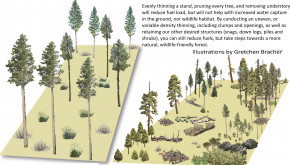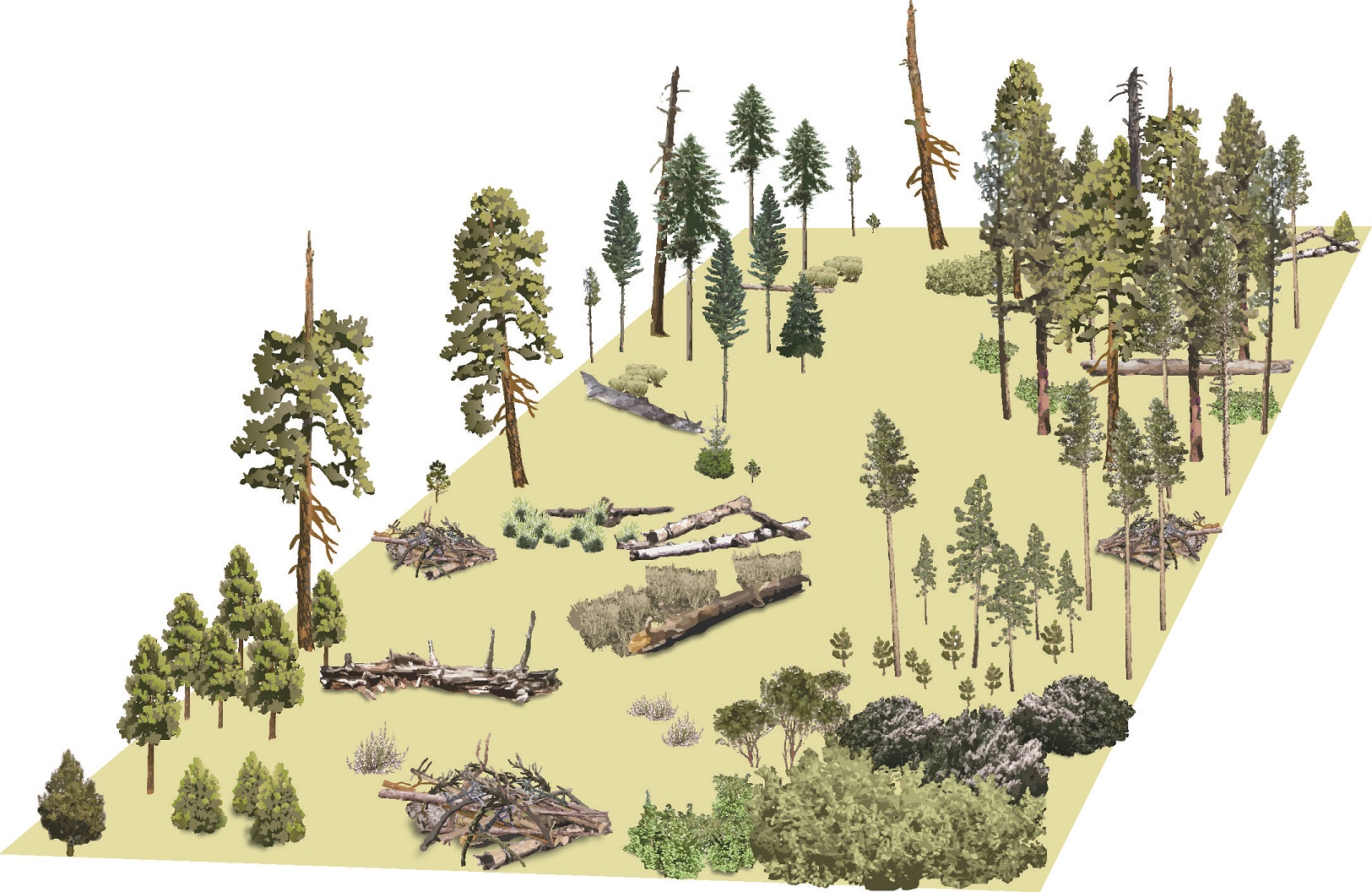
Author: Nicole Strong, Extension Forester, Deschutes/Crook/Jefferson/Confederated Tribes of Warm Springs
Many landowners throughout the Intermountain West, Southwest, and Southeast United States are working on making their forest more resistant to fire. This might include thinning, mowing, or even conducting prescribed burning on your property. Sometimes we get so good at “cleaning up” the forest that we remove valuable wildlife habitat. The good news is you don’t have to sacrifice the safety of your property to keep wildlife value. This article will give you a few ideas on how you may plan your fuels reduction project in a way that creates resilience to fire, improves forest health, looks more natural, and keeps or enhances high quality wildlife habitat.
Remember, you don’t have to eradicate all the fuels on your property to make sure your property is fire resilient; you just need to break up the continuity of fuels, which will reduce the chance of a fire spreading intro the crowns of your trees, and throughout your property. You can create a landscape that is resilient to fire, looks more natural, mimics historic fire patterns, and creates high quality wildlife habitat.
You are going to manage very differently close to home if you live on your property (< 100 feet) vs further out (100 ft +) in the woodlands. This article is focused on managing that ground which is further than 100 ft from a building or residence.

Snags and Down Logs
Some of the most important habitat features in any forest are made of dead wood; specifically standing dead trees (snags) and down logs. Live trees with dead portions of their stems and branches can also fill this role. Insects reside in the dead wood, often feeding on fungi, and birds such as woodpeckers, nuthatches and chickadees feed on these insects. Cavities created by woodpeckers during regular nesting and courtship behavior can provide homes for secondary cavity species such as bluebirds or flying squirrels. Many of these species are voracious feeders on insects, including some forest pests, and thus can help keep the forest healthy if habitat is provided and they can occupy territories. If they do not present a hazard over a road, or near a house, we recommend leaving as many large (10” + diameter) snags and down logs on the landscape as possible. The bigger the snag or downed log, the better!
Shrubs
Many shrub species provide excellent fruit, insects and forage for wildlife species. Clumps of shrubs also provide nesting and hiding cover for birds and small mammals. The shrub species you have will vary greatly with your locale. Sometimes too hot of a prescribed burn can reduce the vigor of shrubs or grasses you care about. Heavy mowing can also result in undesired transition of understory species. Bitterbrush is a very important understory plant in many of our dry forests in the West, as are our native bunch grasses. Almost anything with “berry” in the name is a good choice for keeping or encouraging! The key here is location location, location! Of course you don’t want tall shrubs where you have trees with low hanging branches. This creates ladder fuels, where a fire can climb from the ground up into the crowns of trees. You might consider leaving some clumps of shrubs out in the open.
Openings (Gaps)
Openings can be areas where all, or nearly all, of the overstory trees are removed. These openings allow for the development of shrubs and grasses for wildlife, as well as regeneration of shade intolerant tree species. These can be embedded in stands of trees to allow big game animals to feel secure and to provide habitat for other wildlife associated with edge habitats. Openings usually happened in long sinuous shapes (no more than 50-110’ across) rather than big circles or squares. This allows wildlife to feel safe going out into the open but quickly being able to get back in cover. Emerging research also shows that openings are important for retaining snowpack for those of us who are water-limited in the summer. So openings have many benefits to tree growth, reducing fire risk, and helping wildlife!

Patches (Clumps)
Dense pockets of young conifers and shrubs provide quality habitat for many species, such as feeding or nesting songbirds, and browse and cover for big game. Patch retention in thinning units can provide this habitat, but requires forethought. Mark areas from 30-50 feet in depth at least, and at least the same in length, or preferably longer. These areas should be left unthinned, (or thinned lightly), in order to maintain sight distance cover for large mammals such as deer, elk and bear. Patches should be configured across units to break long sight distances, and staggered at distances of 200-300 feet apart. You don’t want more than 350-500’ between skipped areas.
How Many Clumps/Openings?
If you have less than 10 acres of forest, creating any significant openings might not be reasonable. This is one of those situations when it is beneficial to see what is around you on the landscape and think about what you might offer that is different from your neighbors. If you have 10 acres or more of land, the recommendation is for about 10-20% of your land left as clumps or patches, and 5-15% for openings. This might look like one or two openings of .2-1 acres in size for every 10 acres.
Slash Piles
Piles can be left as distinct habitat elements and act as surrogates for down wood. They will provide cover for many species of wildlife. Best piles for wildlife involve placing at least 3-5 layers of larger logs crisscrossed, or lain lengthwise in triangular 3s. Critters will create nests and dens in the spaces you created. Cover the top with a few layers (about 2-3 feet deep) of fine branches. Habitat piles provide lots of value, and can be used as a slash treatment option. If they did catch fire, they will burn hot only in that spot, and if placed away from overhanging trees will not act as ladder fuels to the crown. Piles should be provided at a similar rate of 2-3 per acre, preferably in clusters away from roads. These are not sources of firewood and should be marked for retention after the work is done and before the other “brush” or “slash” piles are burned.
Timing
If you have the flexibility to conduct your operations in Fall and Winter, then you will reduce the chance of disturbing or destroying bird nests or small mammal dens.
Pruning
Pruning trees helps reduce the ability of a fire to climb up from the ground to the crowns of your trees. Some people really like the way it makes the forest look, neat and tidy, with great visibility. Unfortunately, all that visibility means reduces sight cover. In addition, fledging birds that still haven’t quite caught on to flight and small mammals rely on low hanging branches to move up off the ground, or to hide in the dense foliage. In some situations, if you have a very old tree with large branches, your strategy might be to remove all the vegetation around that tree, or make a small “clump”. You might also prioritize and only prune trees in areas where you have a ladder fuel hazard.
Ultimately, you need to create a management plan for your property that meets your goals, your resources, and the scale of your property. We feel confident that these recommendations can help anyone who is starting to plan a fuels reduction or forest health on their property but is also interested in retaining wildlife and aesthetic qualities.
Resources:
Oregon’s Know your Forest Wildlife Learning Library:
http://knowyourforest.org/learning-library/creating-a-home-for-wild-animals
Oregon State University Extension Reducing Fire Risk on Your Forest Property:
https://catalog.extension.oregonstate.edu/pnw618
Article written by: Nicole Strong, Extension Forester, Deschutes/Crook/Jefferson/Confederated Tribes of Warm Springs

